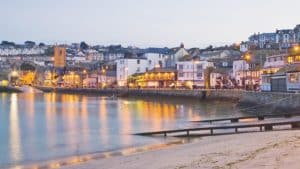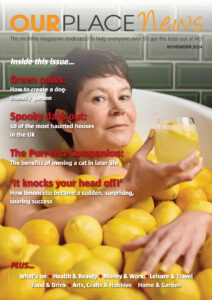With fewer visitors there’s breathing space to enjoy the town’s galleries, seafront restaurants and cosy pubs – and brave the water too.

A trip to the seaside may fix in the mind images of summer – sunny beaches, melting ice cream and long evenings – but there is plenty to enjoy on the edge of the country in the colder months of the year.
It is estimated that an extra 30,000 people visited Cornwall this summer compared to previous years, making it one of the most popular holiday locations in the country. But the county is quiet again, and in artsy St Ives, you can sense that the town has been regained by its residents. For those who do visit out of season, its rich arts heritage, coastal activities and magnificent natural landscape are no less appealing.
Staying in the town is one option, whether in a historic fisherman’s cottage or one of the luxury hotels that hosted foreign dignitaries during June’s G7 Summit. I stayed just outside at the Una St Ives resort, where there’s space and the flexibility of self-catering. Just a short drive from St Ives and a 15-minute walk down to the sweeping sands of Carbis Bay – where the G7 took place – Una comprises lodges, many of which are pet-friendly, clustered around a luxury spa that offers fitness classes, a heated indoor infinity pool and sauna. By 2023, it is set to expand with a hotel.
Whiling away the hours in the winding, cobbled streets of St Ives is easy in all weathers. There are twisting streets lined with independent galleries, cafes and shops; on the harbourfront, restaurants and ice cream parlours overlook turquoise waters that would not be out of place in the Mediterranean, even on the dreariest December day.
The artistic light continues to inspire
It is a seascape that inspired many of the artists whose work now hangs in the St Ives branch of the Tate gallery, which stands braced against Porthmeor Beach. Though it has a varied programme of exhibitions throughout the year, its collection focuses on the St Ives School of local artists. Prominent among them is Alfred Wallis, a fisherman and rag-and-bone-man who used industrial paints and unexpected materials to create primitive but evocative scenes.
A short hop away is the Barbara Hepworth Museum and Sculpture Garden, also managed by the Tate, which displays the artist’s abstract paintings and geometric sculptures in what was once her own studio, home and gardens.
Another cultural highlight is the Leach Pottery, established by Bernard Leach in 1920. Heavily inspired by Japanese ceramics, the pottery kickstarted St Ives’ arts movement in many ways, and was founded on creating pieces which have utility at their heart. Today, a team of seven potters creates “standardware” – made to Leach’s original specifications – alongside their own work, currently on display at the Thrown Contemporary gallery in north London. The pottery offers tours led by local artists, quick “have-a-go” sessions and longer pot-throwing courses.
If you’ve been inspired to pick up pen or paints, there is a variety of art courses and experiences on offer throughout St Ives. Even in the winter months, an outdoor class in either watercolours or sketching offered by Barnoon Arts, led by Peter Giles, is a relaxed way to start
training your hand to capture landmarks like the historic Smeaton’s pier.
Though I haven’t an artistic bone in my body, he taught me a solid grounding of techniques while getting me to see the shapes and lines that make up St Ives’ profile. Feeling inspired, we took our materials and went further afield – a boat trip to Seal Island (starting at £20 pp) to see some marine mammals, then a long ramble along the dramatic coast past Clodgy Point to Zennor, stopping for the legendary ice cream at The Moomaid. My imagination was stirred under grey skies.
The water’s still lovely (but bracing)
And if you’re feeling brave – there’s still the sea. Water temperatures are starting to take a turn, but for experienced cold-water swimmers, heading out into the Atlantic is a bracing experience, tempered by a wetsuit (check conditions via the Coastguard or a website like SurfForecast.com).
For a safer swim, the Jubilee Pool in nearby Penzance is a grand, recently restored Art Deco lido with a large seawater pool and a smaller, geothermally heated pool in which you can wallow as steam rises into the air, listening to the crashing Atlantic waves on the other side of the wall.
As well as art, St Ives is renowned for its surf breaks. From the sandy stretch of Porthmeor Beach the St Ives Surf School teaches novices like me, as well as the more experience. I found it a little daunting at first, but after a few mouthfuls of saltwater I was paddling out, then rising to my knees and eventually standing on a board – if only for a few seconds. The instructors are friendly and encouraging, and the thrill of successfully gliding into shore is exhilarating.
With my energy expended, the harbourside Porthminster Kitchen beckoned. The intimate, simple interior – and sea-view terrace – are reflected in a small but varied menu, built on a basis of fresh sea catches including local oysters and scallops. I devoured a decadent cod fillet with herb gnocchi and a lobster bisque, looking out from the balcony at the early sunset.
Later, the Rum and Crab Shack and the Sloop Inn – the latter one of Cornwall’s oldest inns – were cosy retreats for drinks and dancing to local, live music. St Ives continues to keep spirits high long after the warm summer rays have receded.
Inside tip: Ben Warner, surf instructor
“After a day of swimming or surfing, I love to head down to the Sloop Inn. It’s a beautiful, old, wooden pub that has an amazing atmosphere, especially when there is some live music on. And on a quiet day it feels like a mysterious smugglers’ pub, which it probably was 500 years ago.”
(Story source: Inews)

